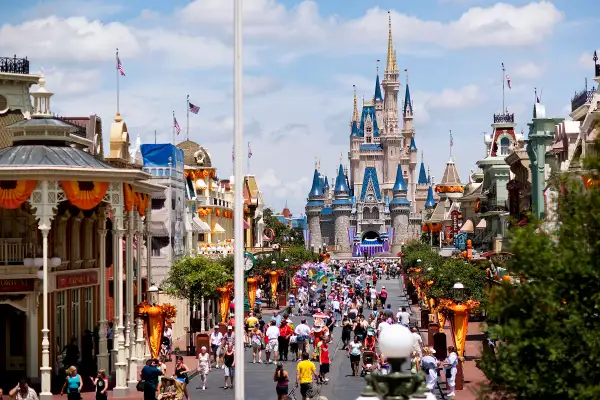Attendance at Disney Parks Is Down for the First Time in a Decade

Last year, Disney World had to turn away guests trying to enter the Magic Kingdom on New Year's Eve because the park was at full capacity—something that's happened only a handful of times over the last few years.
So it may come as a surprise that Disney's parks were actually less crowded in 2016. Attendance at Disney theme parks around the globe declined for the first time in at least a decade, the New York Times reported.
That may sound bad for Disney, but don't expect the entertainment and theme park giant to be all that upset. While attendance dipped significantly at Disney parks overseas—down 14% at Disneyland Paris and down 10% at the park in Hong Kong—visitor numbers at the company's flagship U.S. parks decreased very slightly.
Disney doesn't release theme park attendance figures. However, a new report released by the Themed Entertainment Association (TEA) estimates that attendance fell at every Disney park except one last year (the exception was Shanghai Disneyland, which opened in 2016). In the U.S., the declines were small, with attendance falling by less than 1% in 2016 at each of the three main parks in Florida's Walt Disney World. For example, the Magic Kingdom in Orlando, which has had the world's highest theme park attendance for years, attracted an estimated 20,395,000 visitors last year, down just 0.5% from 2015.
Perhaps most importantly for Disney, despite declining attendance, the company's theme park unit profits were up 9%, hitting $3.3 billion in fiscal 2016. The profit boost occurred during the first year that Disney instituted a variable pricing structure that increased single-day admissions by as much as 20% during certain times of year.
Disney followed that up by increasing admissions prices yet again in 2017. Today, a one-day adult admission to Disney World's Magic Kingdom costs up to $124, compared to $105 in 2015 and $79 in 2010.
To some extent, Disney may be shrinking or at least leveling off attendance by design. Theme park fans have complained for years that the crowds are too big, especially during peak family vacation periods, and many supported the idea of increasing prices or shifting to variable pricing as a strategy to ease congestion and make ride lines more bearable.
Above all, Disney's mission is to increase profits, and it doesn't have to increase visitor numbers to do so—it can accomplish the same goal simply by getting each customer to spend more. And it appears Disney has been very successful with this strategy. Even as attendance declined last year, "revenue was up 5% at domestic operations, reflecting increased guest spending, reportedly driven by higher average prices for admissions to theme parks and cruise line bookings, increased food, beverage, and merchandise spending, and higher room rates," the TEA report explained.
What's interesting, however, is that attendance at Universal Studios—Disney's big theme park rival—increased significantly last year, even though both companies have been raising admission prices in lockstep year after year.
Thanks largely to the enormous popularity of Universal's Harry Potter-themed areas, attendance at the company's two main parks in Florida were up around 5% in 2016, and attendance was up 14% at Universal Studios Hollywood. “I think they’ve been introducing a product that really tickles the fancy of the tourists," Dennis Speigel, president of International Theme Park Services, said to the Orlando Sentinel regarding Universal Studios. The parks may not "have the level of attendance, and they don’t have the revenue that Disney has, but on a percentage basis, they’re growing faster than Disney," he said.
Considering that it will cost a family several hundred dollars per day just for admissions and food at Walt Disney World or Universal Studios, it's well worth looking into creative ways to save money. Here are some tips for saving we gathered from theme park experts.
